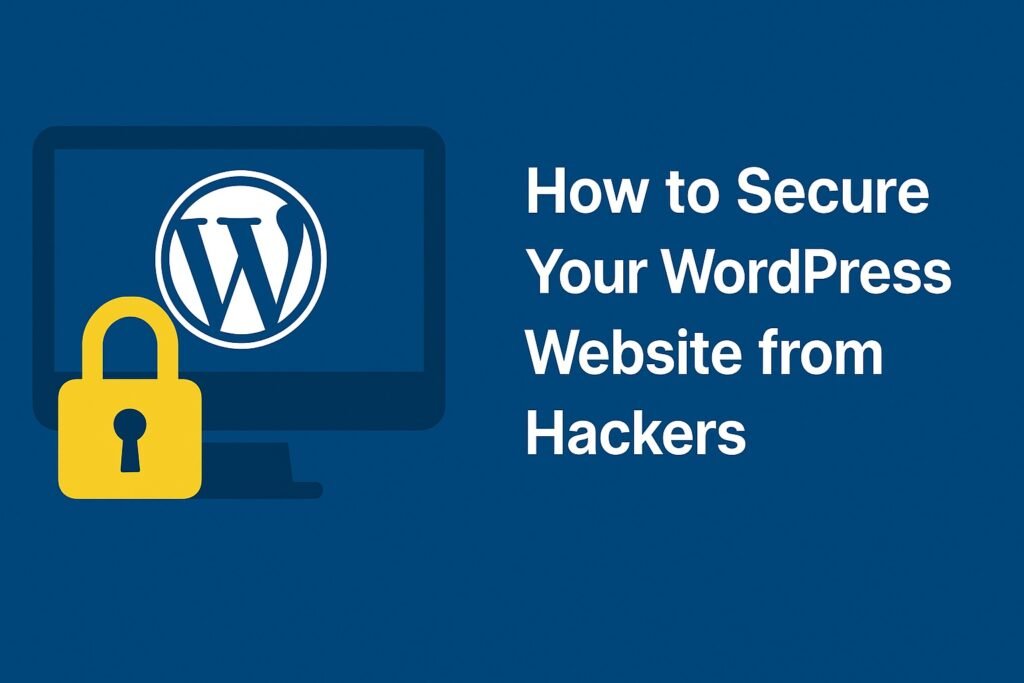In today’s digital world, WordPress powers over 40% of all websites — making it a popular target for hackers. If you’re running a WordPress site, protecting it from cyber threats isn’t optional — it’s essential.
From stolen data to defaced websites, a single vulnerability can cost you time, money, and reputation. Fortunately, you don’t need to be a cybersecurity expert to secure your site. By following some smart practices and using the right tools, you can lock down your WordPress website and defend it against common threats.
In this guide, we’ll walk you through a multi-layered security approach, covering everything from updates and strong passwords to firewalls and file permissions. Whether you’re a beginner or managing multiple WordPress sites, these tips will help you keep your site safe, stable, and secure.
Let’s dive into the essentials that every WordPress user should know.

Let’s go through the WordPress security steps in detail, one by one, so you can protect your site effectively:
🔐 1. Keep WordPress Updated
Outdated software is one of the biggest security risks for any WordPress site.
✅ What to Do:
- Always update the WordPress core to the latest version.
- Regularly update all plugins and themes, especially those from third-party developers.
- Enable auto-updates for trusted plugins, or manage them manually for more control.
💡 Use WP-CLI or a management tool like ManageWP or MainWP if you handle multiple sites.
🔑 2. Use Strong Usernames & Passwords
Weak credentials are a hacker’s easiest entry point.
✅ Best Practices:
- Never use “admin” as your username.
- Use complex passwords with uppercase, lowercase, numbers, and symbols.
- Encourage users (especially admins/editors) to use strong passwords.
🔐 Tools like LastPass, Bitwarden, or 1Password can generate and store secure passwords.
🧱 3. Install a Security Plugin
Security plugins act as a first line of defense.
🔒 Recommended Plugins:
- Wordfence Security
- iThemes Security
- All In One WP Security & Firewall
These plugins offer:
- Firewall protection
- Malware scanning
- Brute-force protection
- Login activity monitoring
📛 4. Limit Login Attempts
By default, WordPress allows unlimited login attempts. This can be abused in brute-force attacks.
✅ How to Fix:
- Use security plugins to limit login attempts.
- Temporarily block IPs after a number of failed attempts.
- Use CAPTCHA or reCAPTCHA to prevent bots.
🔐 5. Enable Two-Factor Authentication (2FA)
2FA adds another verification layer beyond just username and password.
✅ Tools for 2FA:
- Google Authenticator
- Wordfence 2FA
- WP 2FA plugin
Even if someone gets your password, they can’t log in without the second factor.
🚫 6. Disable File Editing in the Dashboard
WordPress allows file editing (themes/plugins) from the dashboard — but that’s risky.
✅ How to Disable:
Add this to your wp-config.php file:
define('DISALLOW_FILE_EDIT', true);
This prevents hackers from injecting malicious code if they gain access.
📁 7. Protect wp-config.php and .htaccess
These two files are critical. If exposed, attackers can access sensitive data.
✅ Secure via .htaccess:
<Files wp-config.php>
order allow,deny
deny from all
</Files>
<Files .htaccess>
order allow,deny
deny from all
</Files>
This blocks browser access to the files entirely.
🧪 8. Regularly Backup Your Website
Backups ensure you can quickly restore your site after a hack.
✅ Recommended Backup Plugins:
- UpdraftPlus
- BackupBuddy
- Jetpack (with backup plan)
Store backups offsite — like Google Drive, Dropbox, or Amazon S3.
🌐 9. Use SSL (HTTPS)
SSL encrypts data between your website and visitors. It’s essential for trust and SEO.
✅ How to Set It Up:
- Most hosting providers offer free SSL via Let’s Encrypt.
- Force HTTPS using a plugin like Really Simple SSL or manually redirect via
.htaccess.
🔐 10. Change the WordPress Login URL
Everyone knows /wp-login.php. Bots scan for it constantly.
✅ Solution:
Use plugins like:
- WPS Hide Login
- WP Hide & Security Enhancer
These plugins let you set a custom login URL like /mylogin123, making brute-force attacks harder.
🚫 11. Disable XML-RPC (if not needed)
Unless you’re using Jetpack or remote publishing, XML-RPC is unnecessary and risky.
✅ Disable via .htaccess:
<Files xmlrpc.php>
order deny,allow
deny from all
</Files>
Or disable with most security plugins in one click.
🧾 12. Set Correct File Permissions
Wrong file permissions allow hackers to overwrite or insert malicious files.
✅ Recommended Settings:
- Folders:
755 - Files:
644 wp-config.php:600
Use File Manager or SSH to set these permissions securely.
👨💻 13. Monitor and Audit User Activity
If you manage a team or accept guest authors, monitor what users are doing.
✅ Useful Plugins:
- Activity Log
- WP Security Audit Log
- Simple History
These plugins log logins, file edits, plugin changes, and more.
🚨 14. Use a Web Application Firewall (WAF)
A WAF filters malicious traffic before it reaches your WordPress site.
✅ Recommended WAF Services:
- Cloudflare (Pro Plan)
- Sucuri Firewall
- Wordfence Premium
These tools block threats like SQL injection, XSS, and bad bots in real time.
👨💼 15. Choose a Secure Hosting Provider
A good host takes care of baseline security.
✅ Choose hosts that offer:
- Free SSL
- Automatic daily backups
- Malware scanning and removal
- Server-level firewall protection
Trusted WordPress-focused hosts: SiteGround, Kinsta, WP Engine, Cloudways.

